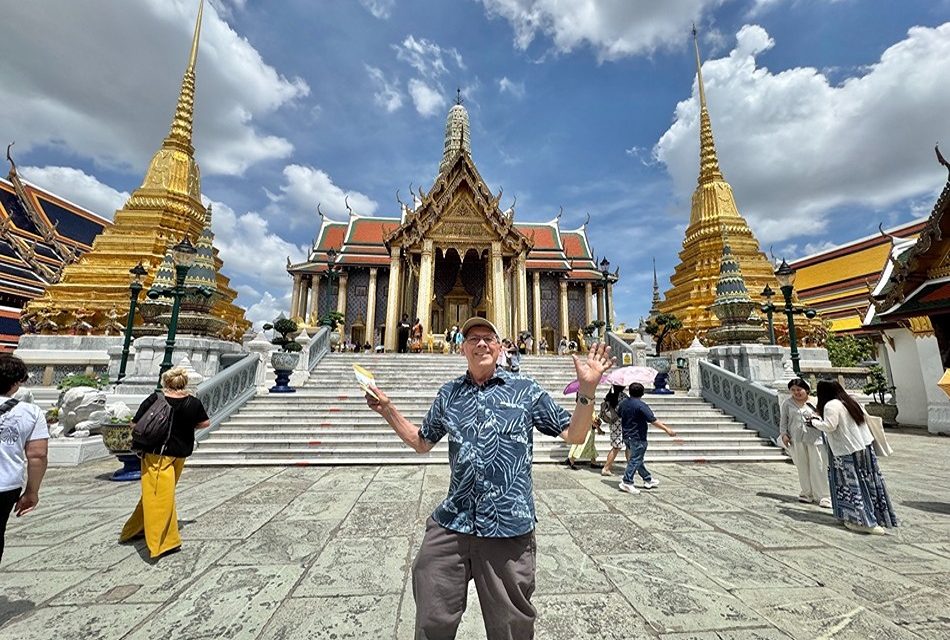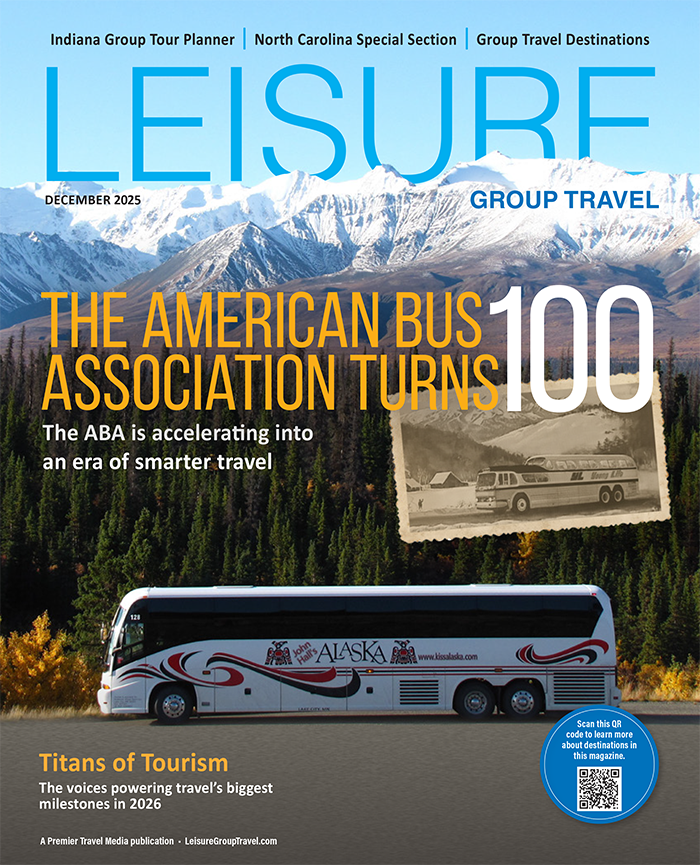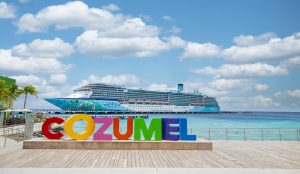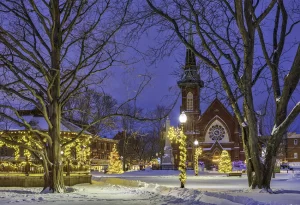Globetrotters find lively markets, serene temples and fun-filled elephant encounters, plus some pretty quirky things, in this Southeast Asia travel hotspot
It was only my second day in Thailand, but I knew then I’d want to return someday for more of its vibrant street life—a multisensory medley of hole-in-the-wall shops, markets brimming with exotic fruits, and outdoor cooking stalls tucked under canopies of plastic tarps, oversized umbrellas and corrugated metal roofs.
From morning to night, the roads are abuzz with motorcycles, motor scooters and Thailand’s iconic tuk-tuks, those three-wheeled vehicles with a bench in back for passengers or a side cart for hauling things.
On this two-week adventure halfway around the world, I wanted to cram in as many authentically Thai experiences as possible—including a tuk-tuk ride—to make every minute count. Major cities like Bangkok and Chiang Mai, along with rural villages and wilderness areas, provided a well-rounded first-time visit to this trending vacation destination in the heart of Southeast Asia.
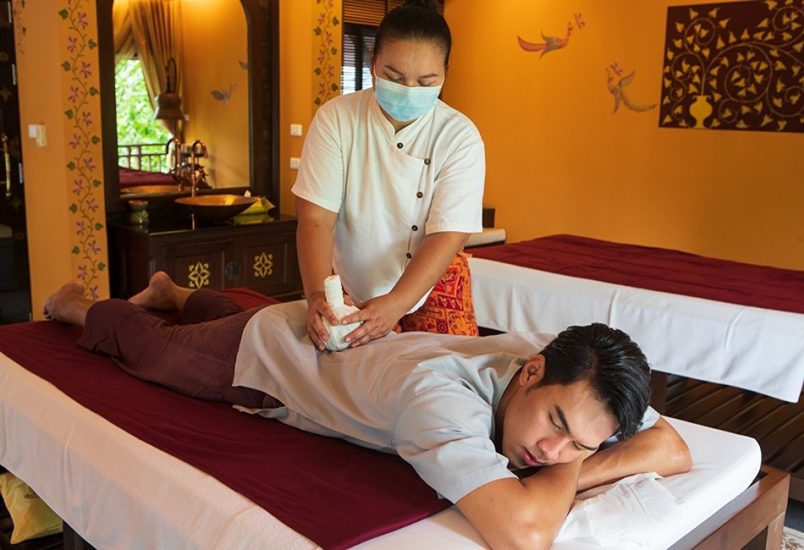
A visit to Thailand is not complete without at least one massage session. (Photo credit: Tourism Authority of Thailand)
Traditional Thai Massage
I am not a spa person, but the art of massage therapy is part of life in Thailand, so I ended up getting three full-body massages during my trip. A reflection of Thailand’s ancient wellness traditions, massages are available everywhere, from fancy hotels and jungle hideaways to temples, airport waiting areas and no-frills storefront parlors.
The most rigorous treatment was in Chiang Mai at Let’s Relax, a reputable chain. After a foot washing and change into pajamas, I spent the next hour-and-a-half being pummeled, pounded, pulled, pushed and pressed by a young masseuse who expertly stretched my body with knees, elbows and feet, as well as hands, while I lay on my back and then stomach. Had I had wanted gentler pressure, I could have told her “bow, bow,” as my tour guide had advised beforehand. But I chose to endure the real deal.
Awe-inspiring Temples
Gleaming with golden spires and adorned with vividly painted carvings, Buddhist temples brighten the bleakest urban landscape. Most Thais are Buddhist, and these color-splashed houses of worship are pillars of the community.
In Chiang Mai, my hotel was located next door to Wat Chai Mongkol, a place I visited several times just to watch people come and go as they left offerings and went inside to pray. Not far away, the maze-like alleys of Chiang Mai’s historic Old City, enclosed by a moat and the original walls, contain more than 40 temples.
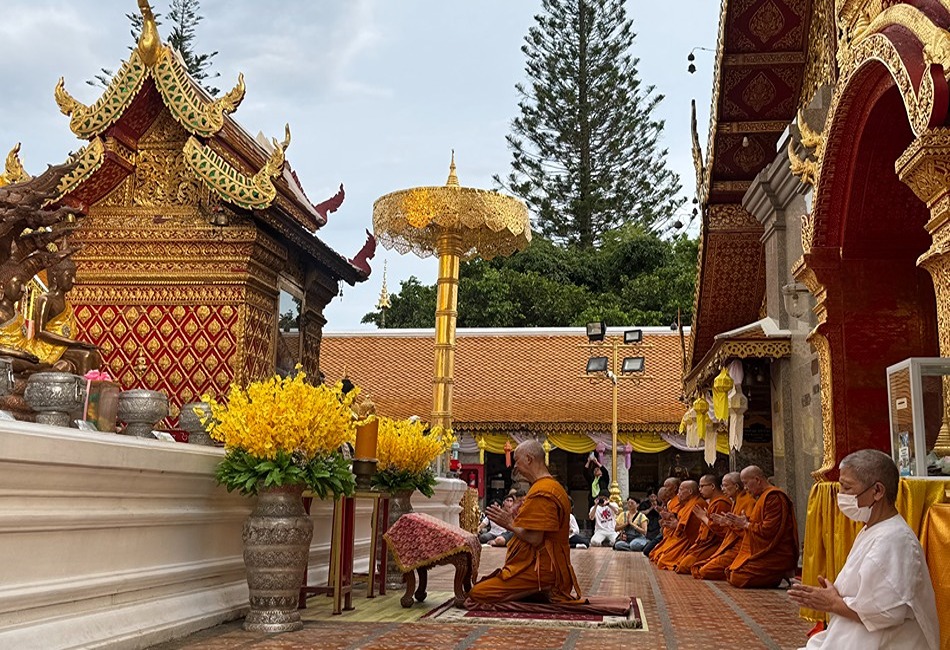
Wat Phra That Doi Suthep, a mountaintop Buddhist temple high above Chiang Mai. (Randy Mink Photo)
My favorite temple experience was at the late 14th-century Wat Phra That Doi Suthep, perched high on a mountain summit overlooking Chiang Mai. Once you arrive at the site of northern Thailand’s most revered temple, a half-hour drive from the city, you can take the funicular railway to the top or, as a true pilgrim would, climb the majestic, 306-step staircase. The vast terrace commands a stunning view of Chiang Mai. We found the orange-robed monks there—and at other temples—to be friendly, and they gladly posed for pictures.
Located inside the Grand Palace complex in Bangkok, Wat Phra Kaew is Thailand’s holiest temple and the home of the Emerald Buddha, the nation’s greatest treasure. Carved from a single piece of jade, the figure is only 26 inches tall.
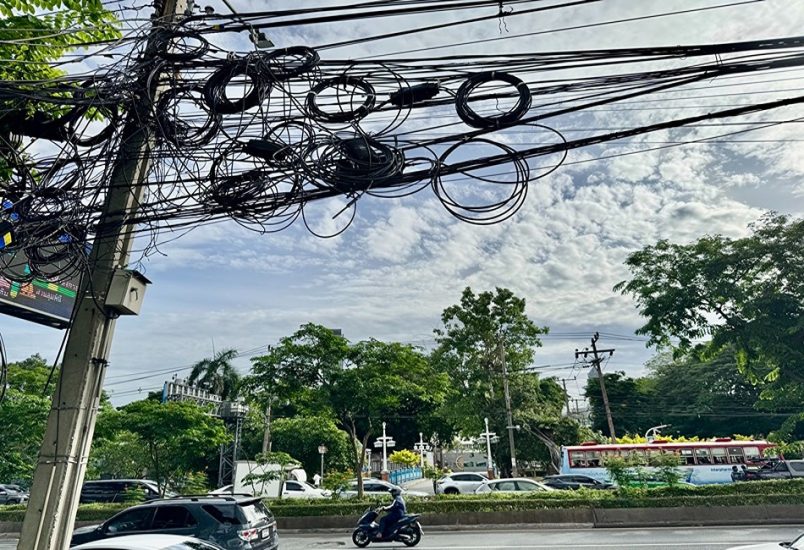
Ribbons of black wire accent urban landscapes. (Randy Mink Photo)
Tangled Wires
Thailand’s cluttered streetscapes are festooned with thickets of black wires stretching for miles from pole to pole and building to building. A sight to behold and practically a work of art, the slashing lines, whimsical knots, coiled garlands, hanging loops and dangling ends seem to pop up in every picture you take.
Spiderman would have a field day in these tangled webs, which apparently are connected to something that provides power. Instead of going to a museum to see abstract art, just look up and admire the creations of utility workers.
The World’s Stinkiest Fruit
Most North Americans have never heard of durian, a fruit common in Southeast Asia. I first encountered the name when checking in to my Chiang Mai hotel. A sign on the front desk indicated that durian was not allowed in guest rooms. I saw a similar sign, with a red slash mark inside a red circle, at a Bangkok subway station.
Durian’s smooth, pale yellow flesh comes in a spiky husk about the size of a honeydew melon. Even when it’s not cut open, the smell is evident as soon as you walk into a small store. The pungent odor is truly awful. Some have compared it to raw sewage. To me it has hints of onion and artichoke. Durian is sold everywhere—in supermarkets, convenience stores, outdoor markets and roadside stands. You can buy freeze-dried slices in a bag or sample the taste in cookies, snack chips, cakes, chewing gum and ice cream.
Since my guide knew I was curious about the fruit and its “perfume,” she bought me two pieces of freshly cut durian at a produce market in Chiang Mai. I liked the pudding-like texture, but the overpowering scent was off-putting, to say the least. We kept the leftovers in the van for a while, but eventually the driver told us that it had to go—fumes were escaping from the package and into the air-conditioning.
Chiang Mai’s Night Market
My best memories of Chiang Mai, a tourist magnet of 200,000 in northwestern Thailand, take me back to the stalls of its famous night market. Hundreds of vendors throng sidewalks, open-air plazas and covered spaces for block after downtown block. A favorite of tourists and locals alike, it’s one big party for revelers and curiosity seekers who come to eat, shop and people-watch. Street entertainment could include anything from dance groups to a solo singer belting out 1960s pop tunes. Portrait artists in one passageway add to the festive ambience.
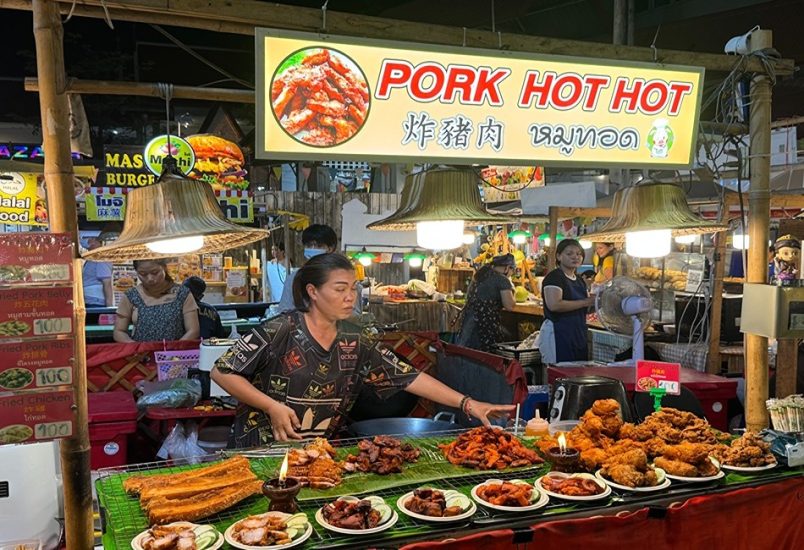
The nightly bazaar, which goes on until midnight, is a good place to pick up a souvenir of Thailand, whether a soccer shirt, batik-print dress, silk scarf or elephant figurine. There are handwoven handbags and pillows, plus jewelry, teas and essential oils.
From one food vendor I bought sticks of chicken satay coated in spicy peanut sauce. Also tempting were noodle dishes, fried chicken, fried fish, barbecue pork ribs and dumplings filled with pork, crab or shrimp. At a stand griddling up roti (a crepe-like pancake), I treated myself to a double dessert—one roti filled with banana and Nutella, the other with mango. For easy eating, they were cut into squares and came with a pair of little sticks that served as utensils.
Sticky rice (khao niao), the most ubiquitous Thai dessert, also appealed to my sweet tooth. The steamed, short-grain rice is flavored with sweetened coconut milk and topped with slices of fresh mango.
Papaya salad (or som tam), a Thai staple, is another big seller at the bazaar. Sweet, sour, spicy and salty at the same time, the refreshing salad mixes shredded green papaya (not the ripe orange flesh commonly served at hotel breakfast buffets) with fresh garlic, chili spices, tart lime, sugar and salty fish sauce (or a pinch of salt). It might be topped with small pieces of green beans and roasted peanuts.
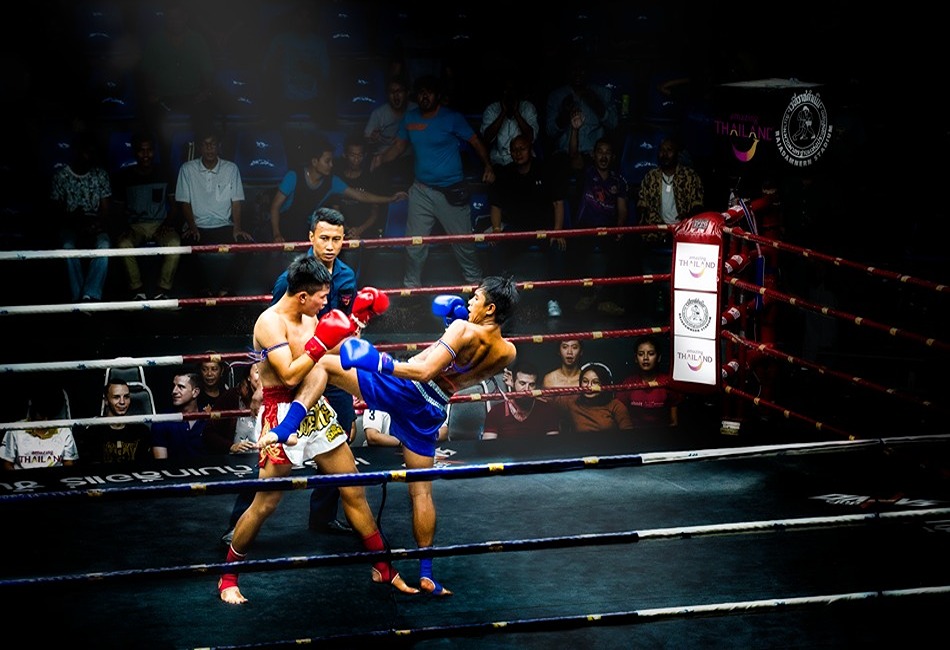
Boxing is a wildly popular spectator sport in Thailand. (Photo credit: Tourism Authority of Thailand)
Thai Boxing
Muay thai, a martial art related to boxing and kickboxing but distinct from both, is the country’s national sport, so I thought I should take in a few rounds. I didn’t have to look long for a venue because the Fairtex Boxing Stadium was located in a pavilion neighboring Chiang Mai’s night market. For about $18 US I bought a ticket and watched some pretty intense fighting in a hot arena cooled only by a big fan.
This wasn’t boxing at the highest professional level, but it satisfied my curiosity, and I witnessed some dramatic knockouts that called for the medical technician to enter the ring. A combat sport for sure, muay thai involves striking with fists and feet, elbows and knees. I was surprised that some of the young competitors hailed from far-flung parts of the world—England, Belgium, United States—as well as from Thailand.
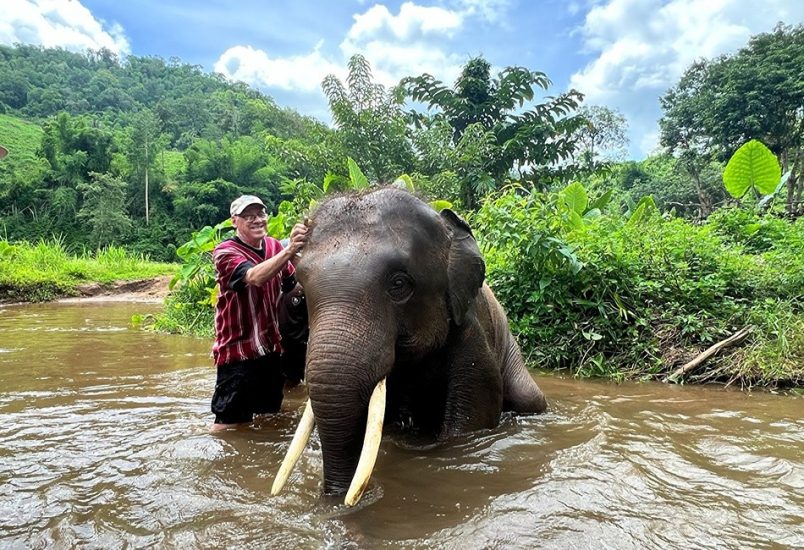
Patara Elephant Conservation, a sanctuary in northern Thailand, offers hands-on encounters.
Land of Elephants
A trip highlight was Patara Elephant Conservation, one of many elephant sanctuaries in the mountainous north. At this home to 24 domesticated pachyderms (descendants of beasts of burden in the teak logging industry), I had a chance to bathe one in a muddy creek. From a thatched platform in the forest, our group fed sugar cane, corn and bananas to the thick-skinned giants. Each has a name and its own mahout, or handler.
The number of wild elephants in Thailand has dropped by 70 percent in the last 60 years thanks to poaching and urban encroachment; fewer than 3,000 of the endangered beasts remain. Images of the country’s symbolic animal are found in souvenirs of all kinds, from magnets and keychains to tablecloths and loungewear. Long ago, kings rode elephants into battle, and the tuskers are still associated with royalty. Elephant statues grace royal parks and the Grand Palace compound in Bangkok.
At the beginning of a tropical rainforest hike in southern Thailand’s Khao Sok National Park, we saw a “Beware of Wild Elephants” sign and had to dodge elephant dung along the path. Later, we learned the trail closes when there’s more than a 60 percent chance of an elephant encounter. That’s reassuring…I think.
On the hike we not only had to contend with rain that made the trail a torrent of orange-red water but with leeches that attached to our skin and sucked our blood. From my sock and later my leg, one of our guides removed the wormy creature with a folded leaf after spraying it.
Village Life
The Thai government has launched tourism initiatives to help the economies of provincial villages by promoting traditional handicrafts. On a tour from Chiang Mai, our group got a look at how weaving is being revived in a rural community of 460 residents. Under the tutelage of villagers, we had a chance to work with cotton and prepare it for the spinning wheel and loom. Down the road we helped local ladies make a dessert by scraping coconut from the shells and mashing sweet potatoes.
At a town in southern Thailand, our tour group had fun meeting students at a school and learning about natural tie-dyeing using dyes from the nipa palm. Each of us designed our own tie-dyed cotton fabric as a memento to take home.
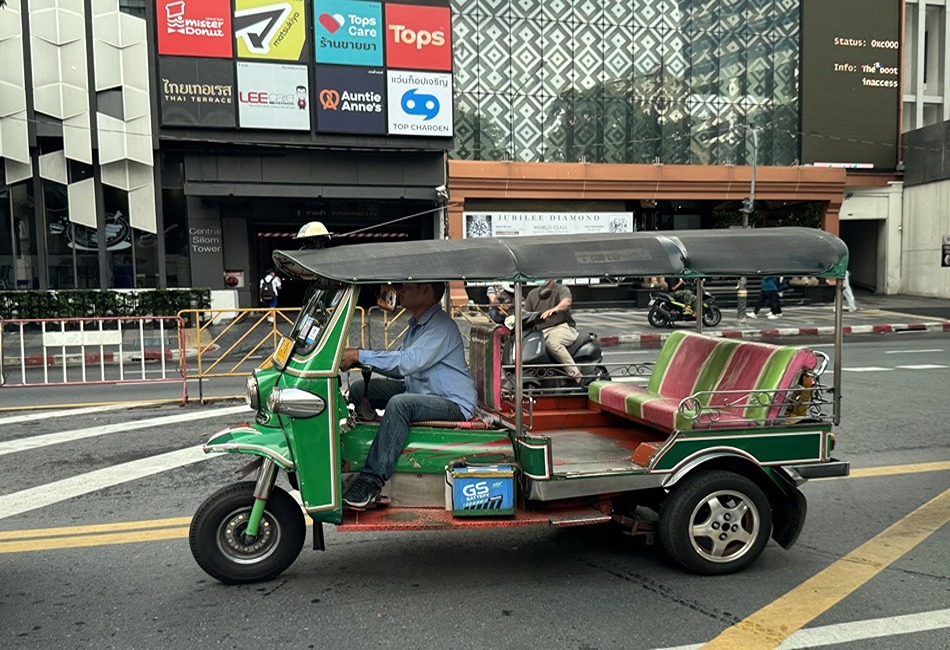
The three-wheeled tuk-tuk, as seen here in Bangkok, plays a big part in transporting people and goods. (Randy Mink Photo)
Bustling Bangkok
Sprawling, sultry and chaotic, this vast megalopolis of 12 million can be overwhelming. It was the last stop on my two-week tour, and I was a little apprehensive about dealing with the heat, pollution and traffic gridlock. But I learned to pace myself and ended up loving Thailand’s capital, wishing I had more than two days to tap into its energy.
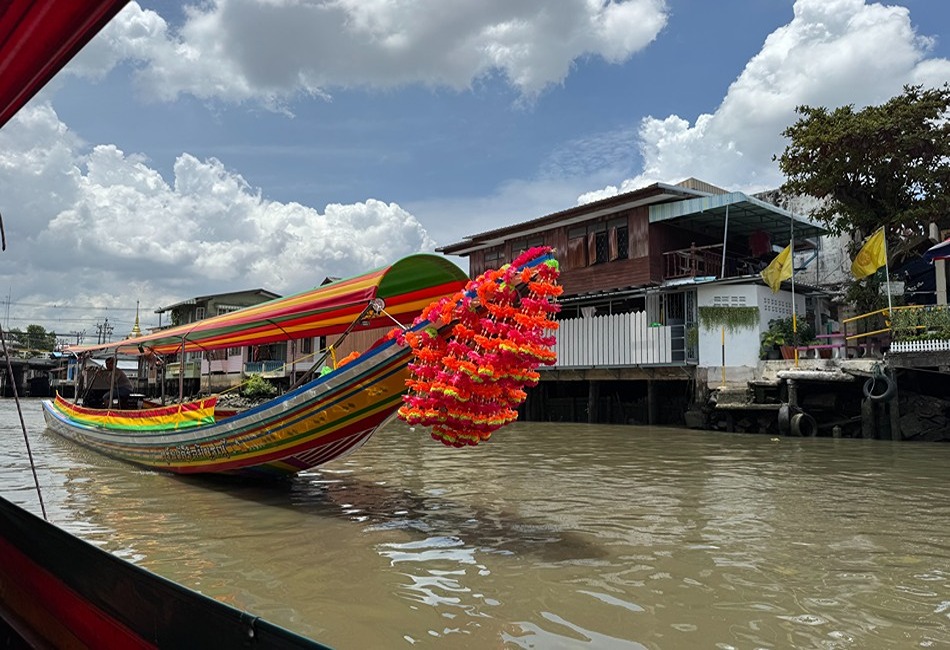
Sightseers get their fill on a cruise through the canals of Bangkok. (Randy Mink Photo)
Seeing the city from the water provides some relief from the congested streets and a different perspective. At a pier on the Chao Phraya River one morning, I boarded a colorfully striped long tail boat for a touristy
canal cruise that glided past wooden houses set on stilts, some of them near collapse. Full of photo possibilities, the tour afforded peeks at temples, workshops, floating vendors cooking up meat, verandas hung with laundry and other slices of daily life. Bangkok was once known as “Venice of the East.”
That evening, I set sail on the Saffron dinner boat, enjoying a multi-course meal before taking in the city lights and river traffic from the top deck. Operated by the Banyan Tree Hotel, the newly renovated Saffron was just one of many such boats plying the Chao Phraya.
The Saffron departed from Iconsiam ,one of the largest indoor shopping malls in Asia. These air-conditioned retail refuges, like the boat cruises, offer welcome escapes from Bangkok’s heat and humidity. At Iconsiam, you can shop for typical souvenirs, try Thai specialties in the food court and patronize high-end retailers like Gucci, Cartier and Louis Vuitton. I stocked up on lightweight elephant-print shirts, shorts, pants and table runners. A vendor on the first level sells fried insects in bulk—grasshoppers, scorpions, crickets, beetles and other creepy sources of crunchy protein for snacking.
Another way to ditch the heat and hubbub after dark is relaxing over drinks in one of the city’s high-altitude bars, most of them in luxury hotels like the 5-star Dusit Thani Bangkok, where I stayed for two nights. The hotel’s open-air Spire Rooftop Bar, on the 40th floor, features views of the skyscraper-studded skyline and Lumphini Park, the green lung of Bangkok’s commercial and entertainment district. Offering the same views behind glass one level below, the enclosed 1970 Bar makes cocktails named after people and events that marked the decade when the original Dusit Thani opened. The menu’s Darker Side of the Moon, for example, is a nod to the Apollo 13 mission in 1970, while other drinks are inspired by movies that starred Ronald Reagan, Sophia Loren and Tom Jones.
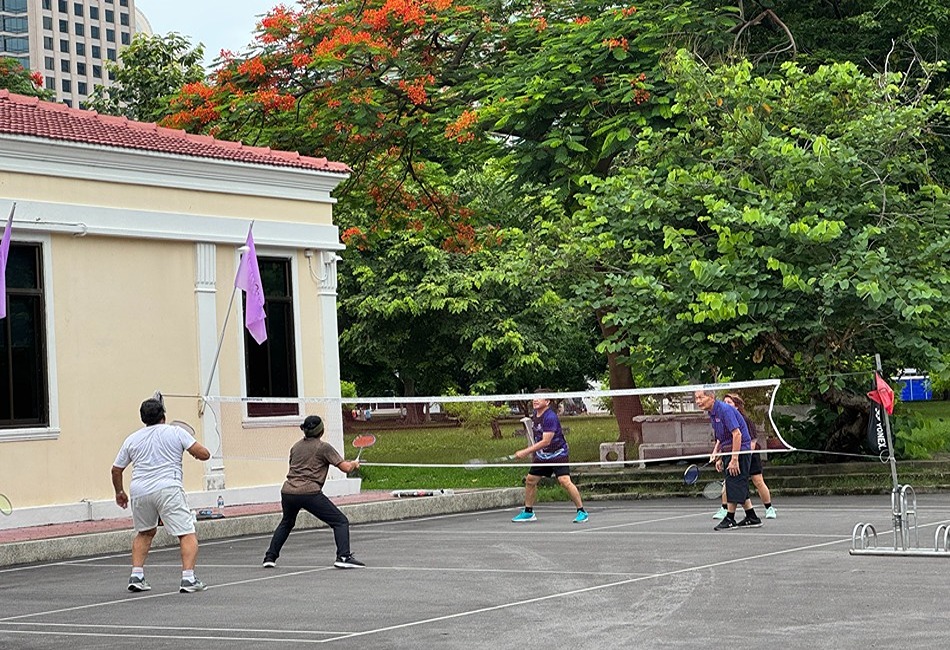
An early-morning game of badminton in Bangkok’s Lumphini Park. (Randy Mink Photo)
Before the day’s steamy heat took over, I made a point of getting up soon after dawn for a walk around the leafy park, an oasis of lakes and well-tended lawns. More important, central Bangkok’s premier greenbelt provided a window on Thai life, as I encountered happy groups exercising to music, working out at fitness stations, playing badminton and volleyball, and practicing the ancient Chinese art of tai chi. Their activities made for great photos, as did the startlingly large monitor lizards that slithered across lawns and sidewalks on their way to and from the lakes.
For travel information, log on to the Tourism Authority of Thailand’s website, tourismthailand.org
For information on other Asian destinations, subscribe to LeisureGroup Travel for FREE.
By Randy Mink, Senior Editor
Lead photo–The author takes in the splendors of the Grand Palace complex in Bangkok.


